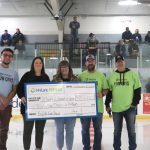Farmer-owned company | Keystone Agricultural Producers part of consortium involved
A consortium of commodity groups in the northern Plains, including Keystone Agricultural Producers in Manitoba, plans to build a $1.5 billion nitrogen fertilizer plant in North Dakota.
Producers from Minnesota, North Dakota and South Dakota want to build a farmer-owned plant, which would use flare natural gas from the Bakken oil deposit to manufacture nitrogen fertilizer.
Don Pottinger, former facility manager of the Simplot fertilizer plant in Brandon, who now runs an agricultural consultancy near Minneapolis, said the proposed plant has captivated farmers and institutional investors.
Read Also

Plant-based ‘meat’ faces turning point
The U.S. firm that owns the Yves brand told CBC News that the “meat free” category has been in decline for several years, so the company made the difficult choice to pull Yves Veggie Cuisine products.
“The folks who understand investment see the nitrogen fertilizer business as a pretty good spot to look right now,” said Pottinger, who told Manitoba farmers about the project at KAP’s July general council meeting in Brandon.
KAP announced July 18 it would have a seat on the project’s board of directors. Canadian farmers will also benefit from the nitrogen plant, which may be run as a co-operative, said KAP president Doug Chorney.
“It’s going to mean a great opportunity for Manitoba farmers to have influence on how the new fertilizer plant is structured.”
Earlier this month, the North Dakota Corn Growers Association announced that a steering committee of growers in the region, with input from fertilizer industry consultants, voted to move the project from the feasibility stage to the business planning phase.
If constructed, it could supply 12 percent of corn and wheat acreage in Minnesota, South and North Dakota, according to the North Dakota Department of Commerce’s website.
Pottinger, who assumed the role of senior commercial and business adviser for the project six weeks ago, has extensive experience in the fertilizer industry.
Raised on a farm near Brandon, he worked for Simplot in the 1970s and managed the company’s fertilizer plant in Brandon in the 1980s.
He later became president of SaskFerco in Belle Plaine, Sask., before working for the fertilizer trade in the United States.
“This is not my first rodeo,” he told a media scrum following his short talk to producers at the KAP meeting in Brandon.
The proposed nitrogen plant would be double the size of the existing Koch facility in Brandon, but project managers are still searching for a suitable site in North Dakota.
The large amount of natural gas coming out of the state’s oil patch, combined with rapid expansion of corn acres in the northern Plains, makes North Dakota an ideal site for a fertilizer plant, Pottinger said.
“Look at it this way, there is a (nitrogen fertilizer) plant in Brandon, there is a plant in Belle Plaine and there are quite a few in Alberta, but there are none in North Dakota, none in South Dakota, Minnesota and none in Montana.”
Given the abundance of natural gas in the region, Pottinger said a nitrogen fertilizer plant is economically viable and offers a strategic hedge against external supplies of nitrogen fertilizer.
Foreign countries now supply two-thirds of the nitrogen fertilizer used in the U.S., he said.
“We will create a stable fertilizer supply that is not dependent on off-shore natural gas supplies and freight costs.”
During the meeting in Brandon, a producer asked Pottinger how much farmer investment is needed to fund construction of a $1.5 billion plant.
Pottinger didn’t provide a specific figure. Instead, he noted that farmers would be given every opportunity to invest in the project.
“The plant (will be) a farmer-owned plant,” he said. “The rest of the necessary funds will come from various sorts of investors.”
At this stage, however, the producer steering committee hasn’t finalized how farmers will invest in the project or details of the ownership structure.

















